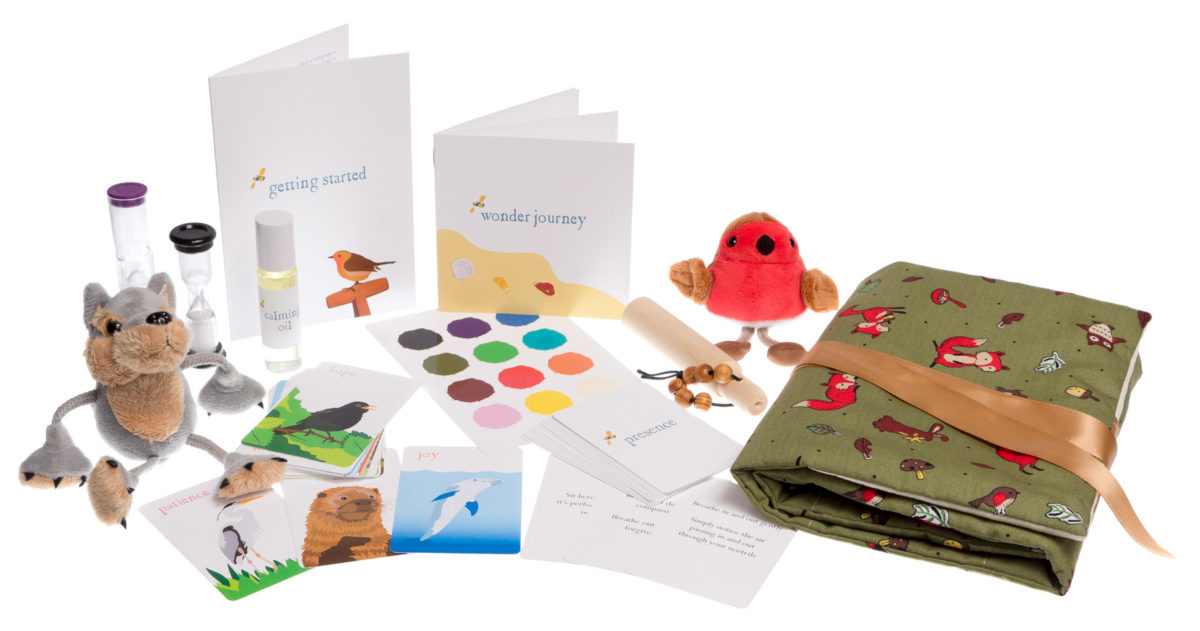We know that meaningful direct work with children and young people is vital to creating a child-centred system, but research suggests that many social work practitioners don’t receive resources or training from their employer to facilitate this work. Our survey suggested that carers receive even less support in direct work.
“Putting Kitbag to Work” sought to fill this gap by providing social workers, family support workers, foster and kinship carers in four local authorities with a direct work resource, designed with insight from psychologists to identify which tools could best lead to cooperation and the building of emotionally literate relationships.
As the project name suggests, part of the toolkit is a physical kitbag. The bags are made of soft, brightly coloured material and contain several resources including calming oil, timers, finger puppets, a talking stick, feeling cards, animal cards, presence cards, and a “wonder journey” mindfulness story. The intention behind this multi-sensory resource was to create something to help children and young people discover ways to talk about their feelings and share their thoughts in a safe place, whilst helping social work staff and carers to reach out, listen and understand what children and young people are feeling.

There is a lack of research into direct work and there is no central agreement about what direct work with children should look like – as these four social workers comment on in their blog for Community Care. We found this issue echoed in our interviews and observations in local authorities, where there was no clear picture of what direct work looked like. Instead it appeared to be largely dependent on the individual social worker and the culture and emphasis on direct work in their wider team and local authority. In interviews, some practitioners suggested that direct work was dependent on how creative, confident and experienced the practitioner was, or how organised they were and how much time they had to plan.
The varied landscape of direct work within and between local authorities meant that the introduction of Kitbag impacted people differently depending on the resources they were already using. For some practitioners and carers, Kitbag acted as a welcome addition to the resources they already used. Others reported a preference for worksheets or activities, like going for a walk or talking without any aids, and felt that Kitbag would not be useful for the children and young people they work with. Kitbag appeared to introduce the most substantial change to practice for the practitioners who expressed a desire to use direct work tools, but felt they lacked access to resources and knowledge of how and when to use them. For them, it appeared Kitbag was able to help fill this gap.
The number of practitioners and carers interviewed was small, so we cannot make judgements on its impact on practice more widely, but we heard positive accounts from those that had used Kitbag. Social workers, family support workers and foster carers found that using the resource facilitated communication and expression of emotion, in some cases creating a safe and open environment for serious disclosures. Practitioners also described using Kitbag as a good ice breaker with both children and their families.
Furthermore Practitioners reportedly found using Kitbag to be a more “organic” and “intuitive” approach, allowing families to relax and process their thoughts and feelings. It was even seen as introducing a shift in the power dynamic between the practitioner/adult and the child, allowing more child directed play and communication. And while some felt Kitbag was inappropriate to use with teenagers, others found this age group liked it. Some practitioners even used Kitbag in their team meetings, and found it encouraged staff to check in on each other.
What emerged strongly from our research was the shake up to direct work which was welcomed by Practitioners. They enjoyed the opportunity to try new things and be inventive and creative. Particularly, they enjoyed sharing knowledge and tips with other social workers, family support workers and foster carers across local authorities, which they felt led to a cross pollination of ideas.
All children are different, and there is no approach that will work for every situation. Similarly, our pilot suggested that there is no “one size fits all” for direct work. Practitioners have their own style, and this is highly dependent on the child or young person they are working with. We spoke to foster carers who loved using Kitbag with one child in their care, but found it would not work with other children or young people.
A key conclusion was that our pilot revealed gaps in research knowledge around how foster and kinship carers define and engage in direct work, and indeed whether this is a meaningful term to them. At the end of the report, we concluded that there is would be great value in doing more exploratory research into what tools social workers would like to use in direct work, and suggested there could be co-development with practitioners and carers themselves.
Unfortunately due to a small sample of people using Kitbag, we weren’t able to quantitatively assess the impact of using the toolkit, meaning we are not in the position to strongly recommend the resource or further impact evaluation. However, interview data suggests that there are no significant harms to using Kitbag, and some practitioners and carers found using the bag aided their communication. We therefore recommend making Kitbag available to practitioners and carers, along with other direct work resources.

